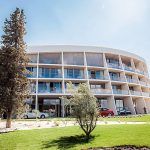Ten European cities have united in the RetaiLink project to revive their historical core by strengthening retail sales. They include Fermo (Italy), Pecs (Hungary), Bistrita (Romania), Liberec (Czech Republic), Hengelo and Hoogeveen (Netherlands), Basingstoke and Deane (United Kingdom), and Croatia’s Šibenik, reports Goran Rihelj for HRTurizam on February 19, 2019.
The vast majority of small and medium-sized cities have trouble keeping retail shops alive within city centers. The causes are different for individual cities, but the common themes run along the lines of shopping centers opening in the suburbs and beyond the borders of cities, offering a unified retail offer along with entertainment, easy access to cars and free parking, growing online sales and consumer changes.
The city of Šibenik is primarily affected by the decline in retail sales, because, in addition to the common problems of small and medium-sized cities in the EU, they have additional issues of traffic, especially in the number of parking places in the city center, the lack of large sales spaces, expensive reconstruction of protected objects and the pressure to apartmentize the area, which takes up space and raises rent for traders.
An action plan that focuses on the cooperation of city administration and retailers, incentives for businesses in the old city core, encouraging traders to increase competences, reducing the seasonality effect, marketing activities to increase the attractiveness of the city center and measures to improve the accessibility of the city center, has been made.
The town of Šibenik has already defined some of the measures for facilitating business for entrepreneurs operating in the area of the old city core, and now, as part of the entire project, has the desire to revitalize the old city core through manifestations.
Thus, the project “Idemo do Grada” (Let’s Go to the Town) was created, which aims to stimulate the manifestation and organization of cultural-entertainment and eno-gastronomic content exclusively in the area of the old city core as a cultural and historical complex.
Focusing the content on the old town, a public call for non-refundable funds from the Šibenik Tourist Board was also announced and relates exclusively to events in the pre-season, i.e., in March, April, and May, and in the post-season, respectively in October and November.
This is an interesting initiative and project of the Šibenik Tourist Board, because the old city core is one of the most valuable resources of the city itself. If the town is deserted and does not offer content within the old city center, then there is a massive flaw in the development of Croatia’s tourism.
The old city core should be the pulse of every tourist destination, shouldn’t it?
To read more about travel in Croatia, follow TCN’s dedicated page.










